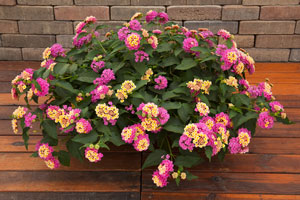4/28/2014
A New Lantana for the Landscape
Karl Trellinger

The Landscape Bandana lantana series is a new and different class of lantanas compared to the original Bandana lantana series. They have a vigorous, semi-trailing habit and are ideal for in-ground plantings, or large single or mixed-species containers.
Propagation of unrooted cuttings
The propagation of the Landscape Bandana varieties is similar to the Bandana varieties. The primary difference is that they should be pinched after they’re rooted, usually three weeks after sticking.
Similar to the Bandana varieties, the cuttings should be stuck immediately upon arrival. They’re slow rooters and need warm temperatures of about 74F (24C). The rooting time is about five weeks in 105-size flats. It’s important to keep the leaves hydrated immediately after sticking; however, over-misting will lead to Botrytis.
After sticking, spray Capsil fungicide at 4 oz./100 gal., plus Daconil fungicide, to prevent Botrytis. If Botrytis is present, spray Daconil or Palladium fungicide around day 9 after sticking.
HID assimilation lighting will help under northern climates when mid-day light levels drop below 1,500 foot-candles (< 7 mols/day). Begin feeding with 100 ppm N when roots start to form (about two weeks after sticking).
Once the cuttings are rooted (around two weeks after sticking), spray B-Nine + Cycocel at 2,500 + 1,000 ppm, respectively.
Grow time (from rooted cutting)
The recommended container size for Landscape Bandana varieties is a 12-in. or larger basket or patio pot with 4 to 5 plants per pot. The grow time is 10 to 11 weeks. For large and showy baskets, a second pinch is recommended, which results in a grow time of 12 to 13 weeks. The grow time for a gallon or 2.5-qt. container with two plants per pot is 10 to 11 weeks.
Pinching
One pinch (ideally in propagation) is sufficient for gallons and 2.8-qt. containers. Leave two or more sets of nodes when pinching. One pinch in propagation and another around five weeks before finishing are best for large, showy baskets.
Fertilizer rate
Apply 200 to 250 ppm N using Cal-Mag fertilizers (i.e. 13-2-13, 15-5-15, 14-4-14, etc.) for more compact growth and neutral pH. Use higher ammonium and phosphorus containing fertilizers (i.e. 20-10-20, 15-15-15, etc.) for softer growth and to lower pH. Electrical conductivity (EC) should be between 2.0 and 2.5 mS/cm in a saturated media extract (SME), with a pH between 5.6 and 6.2. Keep nutrition at optimum levels to promote new growth and flowering. Lantanas will get pale, yellow foliage and will not bloom profusely if underfed.
Light
Lantanas should ideally receive more than 4,500 foot candles (>15 mols/day).
Temperature
70F to 80F (21C to 26C) day and 65F to 70F (18C to 21°C) night are ideal. Lantanas grow best at warm temperatures throughout production. Avoid overly cold and wet growing conditions, especially during dark and cloudy weather, which can cause fungal root rot, slow growth and small flowers.
PGRs
Foliar sprays of Bonzi at 30 ppm or Sumagic at 20 ppm can be used to control growth. A Bonzi drench at 2 to 3 ppm (depending on vigor) three to four weeks before finishing works well to keep plants compact, especially under hot conditions. Florel can be used early on, but it will delay flowering.
Diseases
Lantanas are sensitive to fungal root rot, especially under cold and wet conditions. Avoid overwatering, especially at low temperatures. If needed, drench with a broad-spectrum fungicide (i.e. Subdue Maxx plus Medallion fungicide combination).
Insects
Scout for whiteflies, aphids and leaf miners. Flagship insecticide provides excellent control of whiteflies, aphids and leafminers. A Flagship, Avid insecticide/miticide and Citation insecticide rotation is the standard for leafminer control. Endeavor insecticide is an excellent tool in aphid management.
GT
Karl Trellinger is a Technical Services Representative for Syngenta Flowers, Inc.